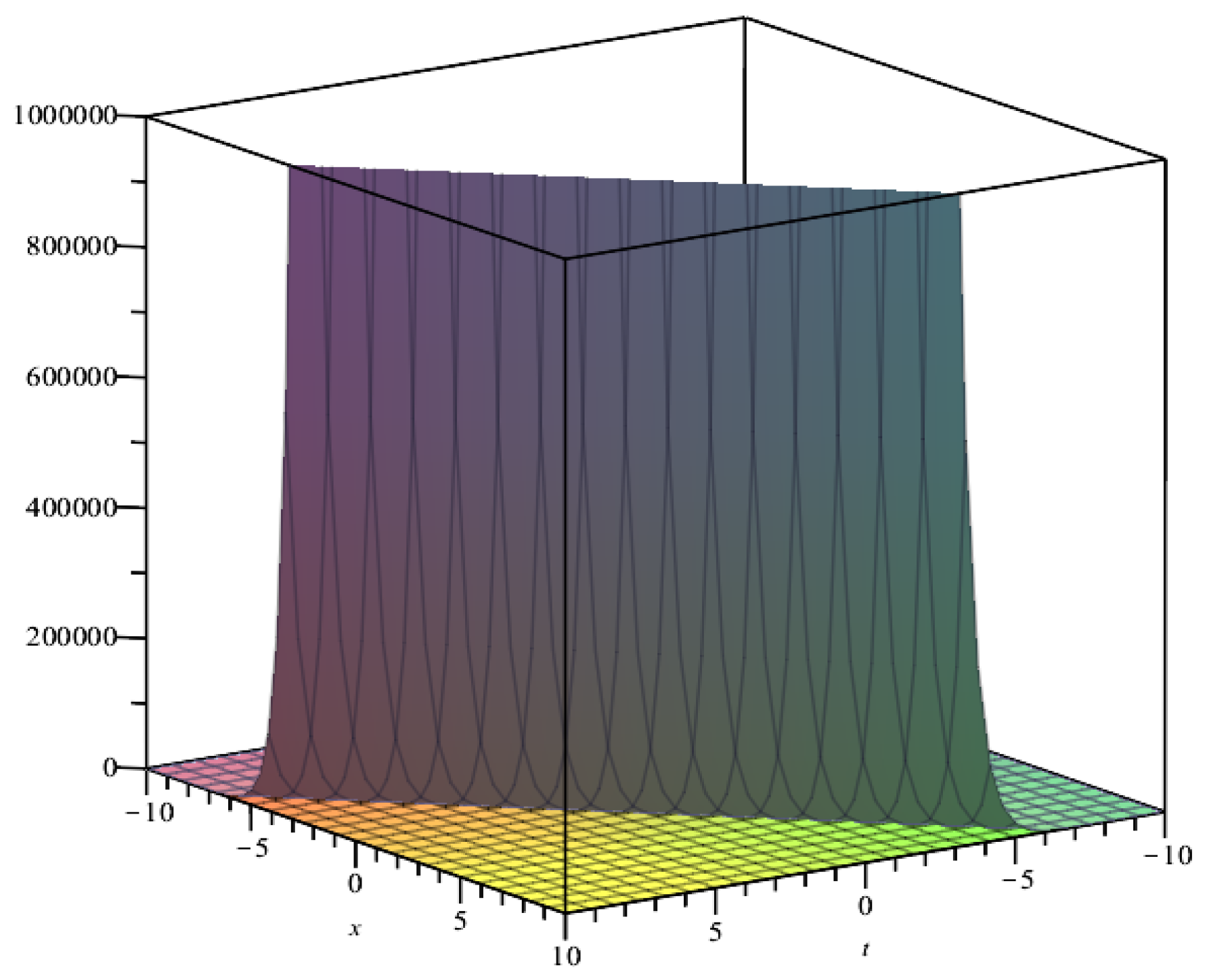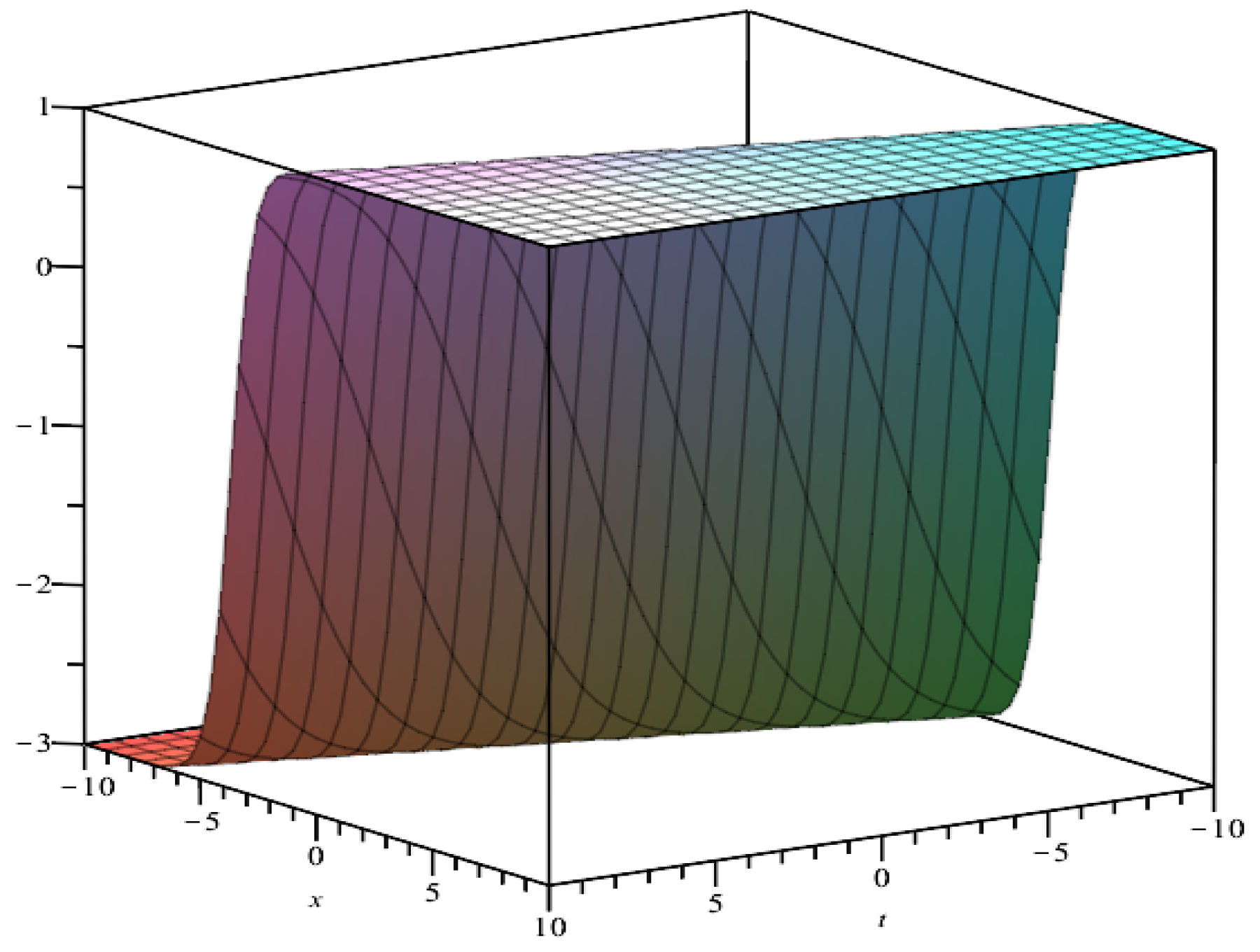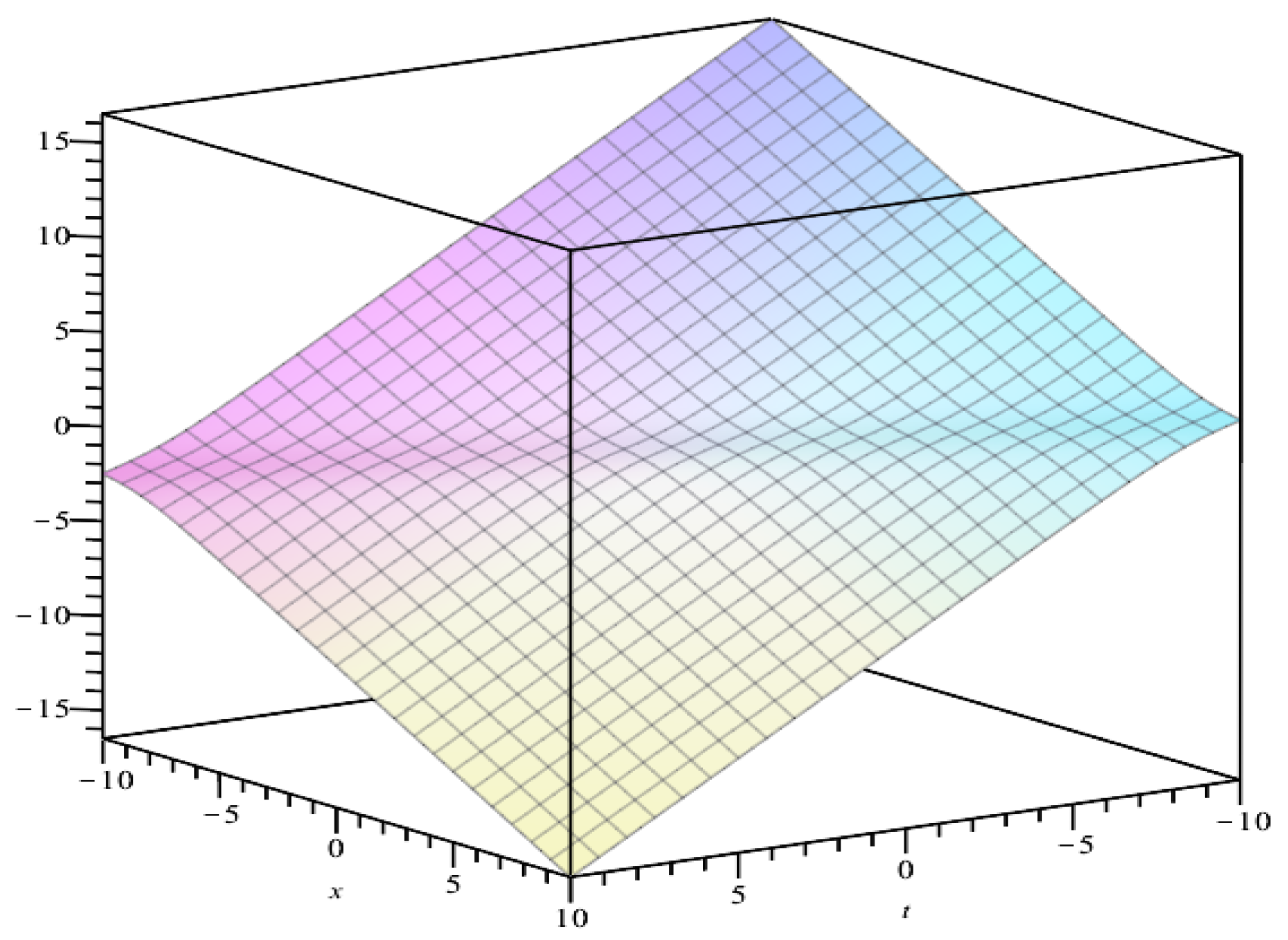Exact Solutions of Nonlinear Partial Differential Equations Using the Extended Kudryashov Method and Some Properties
Abstract
:1. Introduction
2. Simple Description of the Method
3. Exact Solutions of the Boussinesq Class
4. Exact Solutions of the Shallow Water Wave Equation
5. Lie Symmetry Analysis
5.1. Lie Symmetry and Lie Group
5.2. Canonical Coordinates and Invariant Solution
- (i)
- is an invariant surface of Equation (63);
- (ii)
- solves (63). It follows that is an invariant solution of (63) under (64) if, and only if, satisfies when , i.e.,
- (iii)
- , where , for .
6. Self-Adjointness and Conservation Laws
7. Conclusions
Author Contributions
Funding
Data Availability Statement
Conflicts of Interest
References
- Zhou, Y.B.; Wang, M.L.; Wang, Y.M. Periodic wave solutions to a coupled kdv equations with variable coefficients. Phys. Lett. A 2003, 308, 31–36. [Google Scholar] [CrossRef]
- Abdel-Razek, M.A.; Seddeek, A.K.; Abdel-All, N.H. New exact jacobi elliptic function solutions for nonlinear equations using F-expansion method. Stud. Math. Sci. 2010, 2, 88–95. [Google Scholar] [CrossRef]
- Lu, B.Q.; Pan, Z.L.; Qu, B.Z.; Jiang, X.F. Solitary wave solutions for some systems of coupled nonlinear equations. Phys. Lett. A 1993, 180, 61–64. [Google Scholar] [CrossRef]
- Hassan, M.M. Exact solitary wave solutions for a generalized kdv-burgers equation. Chaos Soliton Fract. 2004, 19, 1201–1206. [Google Scholar] [CrossRef]
- Wazwaz, A.M. The sine-cosine and the tanh methods: Reliable tools for analytic treatment of nonlinear dispersive equations. Appl. Math. Comput. 2006, 173, 150–164. [Google Scholar] [CrossRef]
- Li, Z.Q.; Tian, S.F.; Yang, J.J.; Fan, E.G. Soliton resolution for the complex short pulse equation with weighted Sobolev initial data in space-time solitonic regions. J. Differ. Equ. 2022, 329, 31–88. [Google Scholar] [CrossRef]
- Ahmed, H.A.; Mohammad, M.; Lanre, A.; Arzu, A. New solitary waves and exact solutions for the fifth-order nonlinear wave equation using two integration techniques. J. Ocean Eng. Sci. 2023, 8, 475–480. [Google Scholar] [CrossRef]
- Kudryashov, N.A. Exact soliton solutions of the generalized evolution equation of wave dynamics. J. Appl. Math. Comp. Mec. 1988, 52, 361–365. [Google Scholar] [CrossRef]
- Kudryashov, N.A. On types of nonlinear nonintegrable equations with exact solutions. Phys. Lett. A 1991, 155, 269–275. [Google Scholar] [CrossRef]
- Kudryashov, N.A.; Loguinova, N.B. Extended simplest equation method for nonlinear differential equations. Appl. Math. Comput. 2008, 205, 396–402. [Google Scholar] [CrossRef]
- Kudryashov, N.A. One method for finding exact solutions of nonlinear differential equations. Commun. Nonlinear Sci. 2012, 17, 2248–2253. [Google Scholar] [CrossRef]
- Kabir, M.M.; Khajeh, A.; Aghdam, E.A.; Koma, A.Y. Modified Kudryashov method for finding exact solitary wave solutions of higher-order nonlinear equations. Math. Meth. Appl. Sci. 2011, 34, 213–219. [Google Scholar] [CrossRef]
- Roshid, H.; Rahman, M.A. The exp(−ϕ(η))-expansion method with application in the (1 + 1)-dimensional classical boussinesq equations. Results Phys. 2014, 4, 150–155. [Google Scholar] [CrossRef]
- Wazwaz, A.M. N-soliton solutions for shallow water waves equations in (1 + 1) and (2 + 1) dimensions. Appl. Math. Comput. 2011, 217, 8840–8845. [Google Scholar] [CrossRef]
- Bluman, G.W.; Kumei, S. Symmetries and differential equations. Lett. Nuovo C. 1980, 28, 507–514. [Google Scholar] [CrossRef]
- Bluman, G.; Cheviakov, A.F.; Anco, S.C. Applications of Symmetry Methods to Partial Differential Equations; Springer: New York, NY, USA, 2010. [Google Scholar] [CrossRef]
- Gianni, M.; Francesco, O.; Giuseppe, S.; Raffaele, V. Ordinary differential equations described by their Lie symmetry algebra. J. Geom. Phys. 2014, 85, 2–15. [Google Scholar] [CrossRef]
- Olver, P.J. Applications of Lie Groups to Differential Equations; Springer: New York, NY, USA, 1993. [Google Scholar] [CrossRef]
- Zhang, Y.F.; Mei, J.Q. Lie algebras and integrable systems. Commun. Theor. Phys. 2012, 57, 1012. [Google Scholar] [CrossRef]
- Wafaa, B.R.; Hamdy, M.A.; Mohammad, M.; Arzu, A.; Mir, S.H. Investigation of solitons and conservation laws in an inhomogeneous optical fiber through a generalized derivative nonlinear Schrödinger equation with quintic nonlinearity. Opt. Quant. Electron. 2023, 55, 825. [Google Scholar] [CrossRef]
- Akbulut, A.; Mirzazadeh, M.; Hashemi, M.S.; Hosseini, K.; Salahshour, S.; Park, C. Triki-Biswas model: Its symmetry reduction, Nucci’s reduction and conservation laws. Int. J. Mod. Phys. B 2022, 37, 7. [Google Scholar] [CrossRef]
- Wu, T.Y.; Zhang, J.E. Mathematics Is for Solving Problems; Cook, P., Roytburd, V., Tulin, M., Eds.; SIAM: Philadelphia, PA, USA, 1996; p. 233. [Google Scholar]
- Kumar, R.; Pandey, K.S.; Kumar, A. Dynamical Behavior of the Solutions of Coupled Boussinesq-Burgers Equations Occurring at the Seaside Beaches. Braz. J. Phys. 2022, 52, 201. [Google Scholar] [CrossRef]
- Yépez-Martínez, H.; Hashemi, M.S.; Alshomrani, A.S.; Inc, M. Analytical solutions for nonlinear systems using Nucci’s reduction approach and generalized projective Riccati equations. AIMS Math. 2023, 8, 16655–16690. [Google Scholar] [CrossRef]
- Noufe, H. Aljahdaly, Some applications of the modified (G′/G2)-expansion method in mathematical physics. Results Phys. 2019, 13, 102272. [Google Scholar] [CrossRef]
- Anco, S.C.; Bluman, G. Integrating factors and first integrals for ordinary differential equations. Eur. J. Appl. Math. 1998, 9, 245. [Google Scholar] [CrossRef]
- Anco, S.C.; Bluman, G. Direct construction of conservation laws from field equations. Phys. Rev. Lett. 1997, 78, 2869. [Google Scholar] [CrossRef]
- San, S.; Akbulut, A.; Ünsal, Ö.; Tascan, F. Conservation laws and double reduction of (2 + 1) dimensional Calogero-Bogoyavlenskii-Schiff equation. Math. Methods Appl. Sci. 2017, 40, 1703. [Google Scholar] [CrossRef]
- Ibragimov, N.H. Integrating factors, adjoint equations and lagrangians. J. Math. Anal. Appl. 2006, 318, 742–757. [Google Scholar] [CrossRef]
- Ibragimov, N.H. A new conservation theorem. J. Math. Anal. Appl. 2007, 333, 311–328. [Google Scholar] [CrossRef]
- Gazizov, R.K.; Ibragimov, N.H.; Lukashchuk, S.Y. Nonlinear self-adjointness, conservation laws and exact solutions of time-fractional Kompaneets equations. Commun. Nonlinear Sci. 2015, 23, 153–163. [Google Scholar] [CrossRef]
- Ibragimov, N.H. Conservation laws and non-invariant solutions of anisotropic wave equations with a source. Nonlinear Anal-Real 2018, 40, 82–94. [Google Scholar] [CrossRef]
- Ibragimov, N.H. Nonlinear self-adjointness and conservation laws. J. Phys. A-Math. Theor. 2011, 44, 432002. [Google Scholar] [CrossRef]








Disclaimer/Publisher’s Note: The statements, opinions and data contained in all publications are solely those of the individual author(s) and contributor(s) and not of MDPI and/or the editor(s). MDPI and/or the editor(s) disclaim responsibility for any injury to people or property resulting from any ideas, methods, instructions or products referred to in the content. |
© 2023 by the authors. Licensee MDPI, Basel, Switzerland. This article is an open access article distributed under the terms and conditions of the Creative Commons Attribution (CC BY) license (https://creativecommons.org/licenses/by/4.0/).
Share and Cite
Zhou, J.; Ju, L.; Zhao, S.; Zhang, Y. Exact Solutions of Nonlinear Partial Differential Equations Using the Extended Kudryashov Method and Some Properties. Symmetry 2023, 15, 2122. https://doi.org/10.3390/sym15122122
Zhou J, Ju L, Zhao S, Zhang Y. Exact Solutions of Nonlinear Partial Differential Equations Using the Extended Kudryashov Method and Some Properties. Symmetry. 2023; 15(12):2122. https://doi.org/10.3390/sym15122122
Chicago/Turabian StyleZhou, Jian, Long Ju, Shiyin Zhao, and Yufeng Zhang. 2023. "Exact Solutions of Nonlinear Partial Differential Equations Using the Extended Kudryashov Method and Some Properties" Symmetry 15, no. 12: 2122. https://doi.org/10.3390/sym15122122





